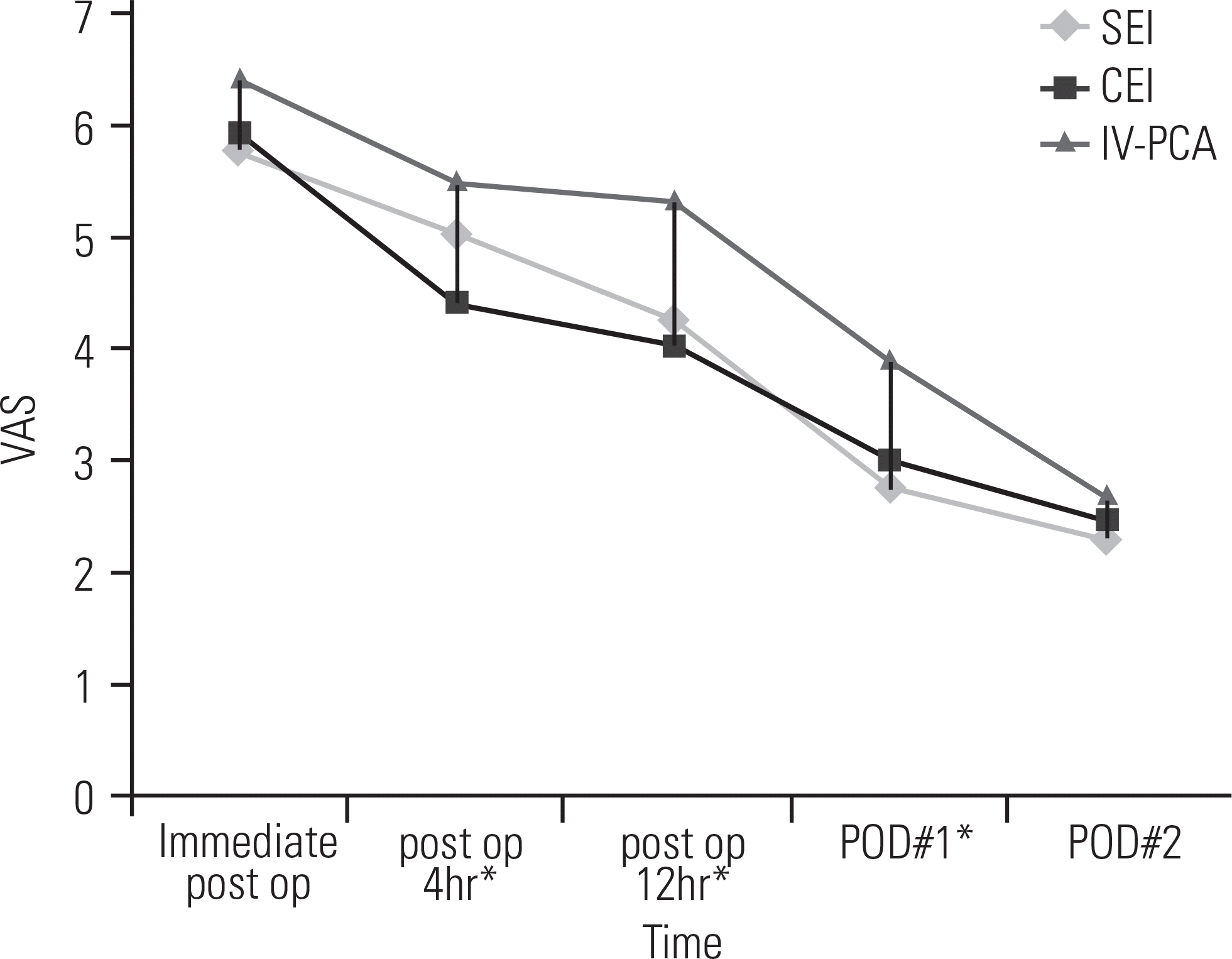Abstract
Objectives
This study compared the early postoperative analgesic effects and the postoperative nausea and vomiting (PONV) associated with 3 methods of pain control after posterior spinal decompression.
Summary of Literature Review
Spinal surgery causes severe postoperative pain. Efficient and safe methods for postoperative analgesia after spinal surgery are necessary.
Materials and Methods
To determine the clinical symptoms and to assess improvements in postoperative pain, 52 patients in whom single-level posterior lumbar decompression was planned were randomly assigned to 3 groups. For postoperative pain control, 18 patients received a preoperative single-shot epidural injection (SEI), 16 patients received a postoperative continuous epidural injection (CEI), and 18 patients received only postoperative intravenous patient-controlled analgesia (IV-PCA). Patient ratings of pain intensity (visual analog scale score from 0 [no pain] to 10 [most severe pain]), nausea (from 0 [no nausea] to 5 [severe nausea]), and vomiting (from 0 [no vomiting] to 5 [severe vomiting]) were recorded immediately after the operation and at 4 hours, 12 hours, 1 day, and 2 days postoperatively.
REFERENCES
1. Bianconi M, Ferraro L, Ricci R, et al. The pharmacokinetics and efficacy of ropivacaine continuous wound instillation after spine fusion surgery. Anesth Analg. 2004 Jan; 98(1):16672. DOI: 10.1213/01.ANE.0000093310.47375.44.

2. Cassady JF Jr, Lederhaas G, Cancel DD, et al. A randomized comparison of the effects of continuous thoracic epidural analgesia and intravenous patient-controlled analgesia after posterior spinal fusion in adolescents. Reg Anesth Pain Med. 2000 May-Jun; 25(3):246–53. DOI: 10.1016/S1098-7339 (00)90006-3.

3. Preble L, Paige D, Sinatra RS. Varying narcotic requirements among orthopedic patients. Anesthesiology. 1990; 73:NA. DOI: 10.1093/bja/74.2.123.
4. Blumenthal S, Min K, Nadig M, Borgeat A. Double epidural catheter with ropivacaine versus intravenous morphine: a comparison for postoperative analgesia after scoliosis correction surgery. Anesthesiology. 2005 Jan; 102(1):175–80. DOI: 10.1097/00000542-200501000-00026.

5. Eilers K, Schenk M, Putzier M, et al. Use of peridural catheters in the treatment of postoperative pain after spinal instrumented fusion–an experience report. Z Orthop Ihre Grenzgeb. 2002 Nov-Dec; 140(6):621–5. DOI: 10.1055/s-2002-36043.
6. Lowry KJ, Tobias J, Kittle D, et al. Postoperative pain control using epidural catheters after anterior spinal fusion for adolescent scoliosis. Spine (Phila Pa 1976). 2001 Jun; 26(11):1290–3. DOI: 10.1097/00007632-200106010-00024.
7. Byung Joon Shin, Jae Min Park, You Il Kim, Uk Park, Chang Uk Choi. The Effect of Epidural Morphine for pain Management after Spinal Surgery. J Korean Soc Spine Surg. 1994 Nov; 1(2):216–222. DOI: 10.4184/jkss.1994.1.2.216.
8. Ferrante FM, Orav EJ, Rocco AG, Gallo J. A statistical model for pain in patient controlled analgesia and conventional intramuscular opioid regimens. Anesth Analg. 1988 May; 67(5):457–61. DOI: 10.1213/00000539-198805000-00007.
9. Harrison DM, Sinatra R, Morgese L, Chung JH. Epidural narcotic and patient controlled analgesia for post-cesarean section pain relief. Anesthesiology. 1988 Mar; 68(3):454–7. DOI: 10.1097/00000542-198803000-00025.
10. Egbert AM, Leland HP, Short LM, Burnett ML. Randomized trial of postoperative patient-controlled analgesia vs. intramuscular narcotics in frail elderly man. Arch Intern Med. 1990 Sep; 150(9):1897–903. DOI: 10.1001/archinte.1990.00390200083016.
11. Sechzer PH. Patient-controlled analgesia (PCA): a retrospective. Anesthesiology. 1990 Apr; 72(4):735–6. DOI: 10.1097/00000542-199004000-00023.
12. Behar M, Magora F, Olshwang D, Davidson JT. Epidural morphine in treatment of pain. Lancet. 1979 Mar 10; 1(8115):527–9. DOI: 10.1016/S0140-6736 (79)90947-4.

13. Joshi GP, McCarroll SM, O'Rourke K. Postoperative analgesia after lumbar laminectomy: epidural fentanyl infusion versus patient-controlled intravenous morphine. Anesth Analg. 1995 Mar; 80(3):511–4. DOI: 10.1097/00000539-199503000-00013.
14. Shaw BA, Watson TC, Merzel DI, et al. The safety of continuous epidural infusion for postoperative analgesia in pediatric spine surgery. J Pediatr Orthop. 1996 May-Jun; 16(3):374–7. DOI: 10.1097/01241398-199605000-00016.

15. Turner A, Lee J, Mitchell R, et al. The efficacy of surgically placed epidural catheters for analgesia after posterior spinal surgery. Anaesthesia. 2000 Apr; 55(4):370–3. DOI: 10.1046/j.1365-2044.2000.01117.x.

16. Cassady JF Jr, Lederhaas G, Cancel DD, et al. A randomized comparison of the effects of continuous thoracic epidural analgesia and intravenous patient-controlled analgesia after posterior spinal fusion in adolescents. Reg Anesth Pain Med. 2000 May-Jun; 25(3):246–53. DOI: 10.1097/00115550-200005000-00007.

17. Schenk Michael R, Putzier Michael, Kügler , Bjoern , et al. Postoperative analgesia after major spine surgery: patient-controlled epidural analgesia versus patient-controlled intravenous analgesia. Anesth Analg. 2006 Nov; 103(5):13117. DOI: 10.1213/01.ane/0000247966.49492.72.
18. Wu Meng-Huang, Wong Chung-Hang, Niu Chi-Chien, et al. A comparison of three types of postoperative pain control after posterior lumbar spinal surgery. Spine (Phila Pa 1976). 2011 Dec 1; 36(25):2224–31. DOI: 10.1097/BRS.0b013e318205e3d7.

19. Klatt Joshua W. B., Mickelson Jennie BS, Hung Man, et al. A randomized prospective evaluation of 3 techniqued of post operative pain management after posterior spinal intrumentation and fusion. Spine (Phila Pa 1976). 2013 Sep 1; 38(19):1626–31. DOI: 10.1097/BRS.0b013e31829cab0b.
20. Maurer K, Bonvini JM, Ekatodramis G, et al. Continuous spinal anesthesia/analgesia vs. single-shot spinal anesthesia with patient-controlled analgesia for elective hip arthroplasty. Acta Anaesthesiol Scand. 2003 Aug; 47(7):878–83. DOI: 10.1034/j.1399-6576.2003.00173.x.

Fig. 1.
Time course of postoperative in the SEI, CEI and IV-PCA groups assessed by VAS. Values are mean.

Table 1.
patient characterics
Table 2.
Side-effects of each pain control methods
| SEI | CEI | IV-PCA | p-value | |
|---|---|---|---|---|
| Nausea | 2(11%) (POD #1) | 0 | 2(11%) (post 12hrs) | <0.001 |
| 3(17%) (POD #1) | ||||
| 3(17%) (POD #2) | ||||
| Vomiting | 2(11%) (POD #1) | 0 | 1(6%) (post 12hrs) | <0.001 |
| 2(11%) (POD #1) | ||||
| 2(11%) (POD #2) |
Table 3.
Visual analogue scales among three groups in consecutive time points after surgery




 PDF
PDF Citation
Citation Print
Print


 XML Download
XML Download